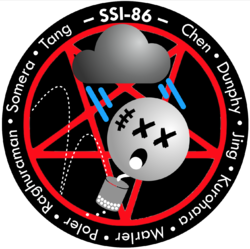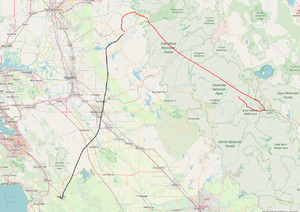SSI-86
| SSI-86 | ||||
|---|---|---|---|---|

| ||||
| Designations | CY-2, BalBal | |||
| Launch date | May 18, 2019, 9:35 PDT | |||
| Launch site | Brigantino Park, Hollister, CA | |||
| Launch coordinates | 36.849, -121.433 | |||
| Flight duration | 5h:12m (first) | |||
| Flight profile | Ballast control (first) Standard latex (second) | |||
| Landing time | May 18, 2019, 14:47 PDT (first) May 19, 2019, 21:10 PDT (second) | |||
| Landing site | 2.3 km SSW of Clinton, Amador County, CA (first) Near Bernice Lake, Yosemite NP, CA (second) | |||
| Landing coordinates | 38.356, -120.675 (first) 37.7677, -119.3281(second) | |||
| ||||
SSI-86 (project designation CY-2; also called BalBal) was the second launch of Project Cycloon on May 18, 2019. It featured a legacy ballast mechanism from ValBal operated by Cycloon avionics and thus marked the beginning of #cy-flops, or Cycloon flight operations. The mission was noted for its low-altitude profile, interaction with inclement weather, pentagram traced out by RockBlock coordinates, and most remarkably, resumption of flight a full 24 hours after presumed flight termination, the only such occurrence in SSI history.
Pre-Launch
After the lessons learned of CY-1, a plan for the remainder of the year was decided upon on April 21. First, due to the avionics issues of CY-1, it was envisioned that a marine tether profile launch would be reattempted in early May. Because it was decided that a grounded tether would be a more suitable means of testing endurance, the requirement on launch windows became much less stringent. Then, on May 11, there was to be a HF communications test module as a payload on a ValBal. Finally, on June 4 there would be a fully altitude-controlled flight using the ValBal ballast mechanism, Apex Vent, and Cycloon avionics.
Data from CY-1 had demonstrated that the floating coefficient of the system was very low and therefore the aerodynamic drag on the balloon very large; it was suspected that high aerodynamic forces during winds led to the termination of that mission. Therefore, the first priority was to design a more effective and hydrodynamic floater. This was done by April 25. On April 28, however, the would-be second launch was cancelled due the ValBal controversy, and the would-be first launch was delayed to mid-May. Furthermore, due to continued delays in the HF transceiver parts supply chain and the overall lack of urgency, the communications test was delayed indefinitely. The mid-May launch would instead aim to test the full extent of the system in the absence of a venting mechanism --- that is, marine tether and ballast mechanism --- by starting as a marine tether, dropping ballast, popping, and landing on land, a so-called float-drop-pop profile.
On May 9, such a float-drop-pop launch window was identified for May 19, 2019, from Santa Cruz, and it was decided to move forward with the launch. By May 12, however, this plan was vetoed due to safety considerations and the lack of a suitable, rural launch site outside the city limits of Santa Cruz. Instead, the launch was planned to be from Hollister (save for a brief consideration of Los Vaqueros Reservoir, which would have preserved the possibility of a float-drop-pop profile), and it would solely test the ballast mechanism under the control of Cycloon avionics. In order to optimize endurance despite a lack of vent mechanism, it was desired to have a launch as late as possible, with an ascent rate as low as possible. Due to forecast rains on May 19, the launch date was moved to the afternoon/early evening of May 18, 2019. Over the course of the week, the predicted arrival of rains became earlier, and the launch time was gradually moved to the morning.
Control of the ballast mechanism and two-way communications of RockBlock were established on May 15 and 16, respectively, and the 3D-printing of mechanical parts and system integration occurred on May 17. Despite the morning launch time, it was hoped to suppress the ascent rate to less 1 m/s, such that the mission would survive sunset and descent overnight. Ballast would then be dropped to equilibrate at a low altitude, and the mission would terminate only after rising and popping the following day --- an trajectory of 18 hours which would lead well into Nevada.
Configuration
Balloon: Kaymont 1500g latex.
Mechanics: ValBal-style cylindrical polycarbonate sheeting, ValBal ballast mechanism, 3D-printed solid top piece with hard attachment point. Parachute in parachute tube. Total payload mass (without ballast) 0.67 kg.
Ballast: 0.5 kg in ballast compartment, 0.75 kg in titration bags. The ballast was split this way because the ballast compartment was under the avionics bay and could not be accessed after system integration. Further, the ballast drop rate of 0.6g/s would have been too slow for titration purposes.
Avionics: BMP280, TinyGPS, Teensy 3.2 reporting all data at regular, fixed intervals via RockBlock modem. 2 solar-charged LED modules. Ballast motor controlled by N-type MOSFET.
Power: 18 L92 lithium AA batteries. In comparison with the standard ValBal complement of 12 L92 batteries, this was thought to be more than sufficient under the most optimistic conditions.
Mass budget: 3.42 kg. Counterweight was designed to balance 3.1 kg of total lift, after which ballast would be removed. In actuality, target fill resulted in nearly perfect buoyancy and no significant ballast was removed.
Flight synopsis
| Balloon Launches | |
|---|---|
| 2014-15 | SSI-19 • 20 • 21 • 22 |
| 2015-16 | SSI-23(a) • 24 • 25 • 26 • 27 • 28 • 29 • 30 • 31 • 32 • 33 • 34 • 35 • 36 • 37 • 38 • 39 • 40 • 41 • 42 • 43 |
| 2016-17 | 44 • 45 • 46 • 47 • 48 • 49 • 50 • 51 • 52 |
| 2017-18 | |
| 2018-19 | 83 • 86 • 87 • 90 • 91 |
| 2019-20 | 92 • 93 • 97 |
| V • E | |
